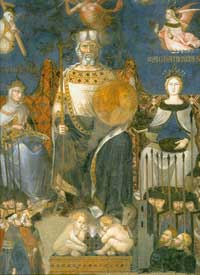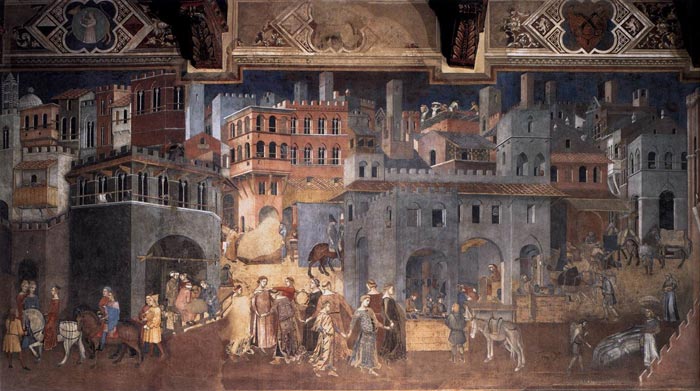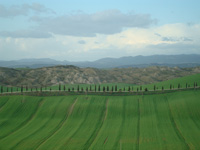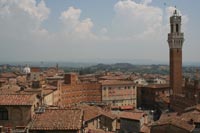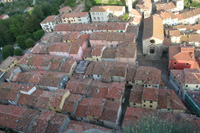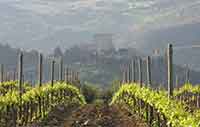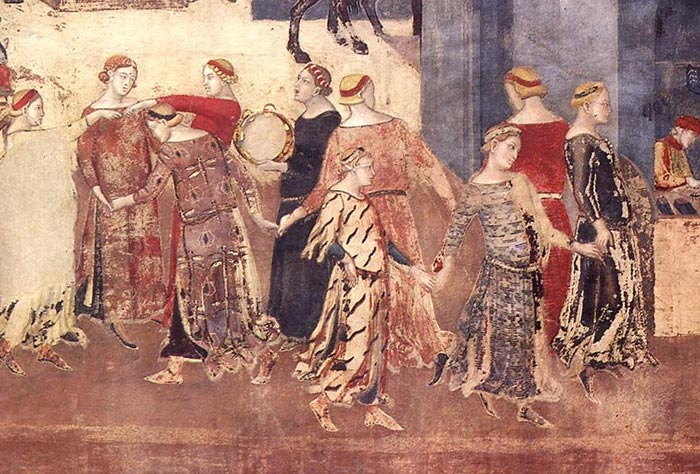 |
|
Ambrogio Lorenzetti, Allegory of Good Government (detail), Palazzo Pubblico, Siena, 1338-40 |
|
Ambrogio Lorenzetti | Allegory and Effects of Good and Bad Government |
Ambrogio Lorenzetti (1290 – 1348) was an Italian painter of the Sienese school. He was active between approximately from 1317 to 1348. Although having done work in Florence, Ambrogio Lorenzetti was known within the Sienese School of painters. This school of painting from Siena, Italy, was an elegant style that was said to rival, at time, even the Florentine painters throughout the 13th and 15th centuries. The Allegory of Good Government carries a strong social message of the value of the stable republican government of Siena. It combines elements of secular life with references to the importance of religion in the city at the time. While classified as medieval or proto (pre)-renaissance art, these paintings show a transition in thought and an evolution in theme from earlier religious art.
|
||||
Allegory of Good Government
|
||||
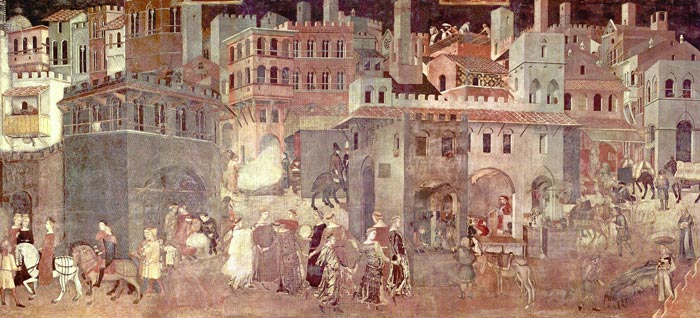 |
||||
Ambrogio Lorenzetti, Allegory of Good Government, Palazzo Pubblico, Siena, 1338-40 |
||||
Ambrogio Lorenzetti was certainly the most inventive Sienese artist of the early 14th century. Many of his innovations in naturalism are without parallel; many of his works are characterized by iconography that is equally original.
|
||||
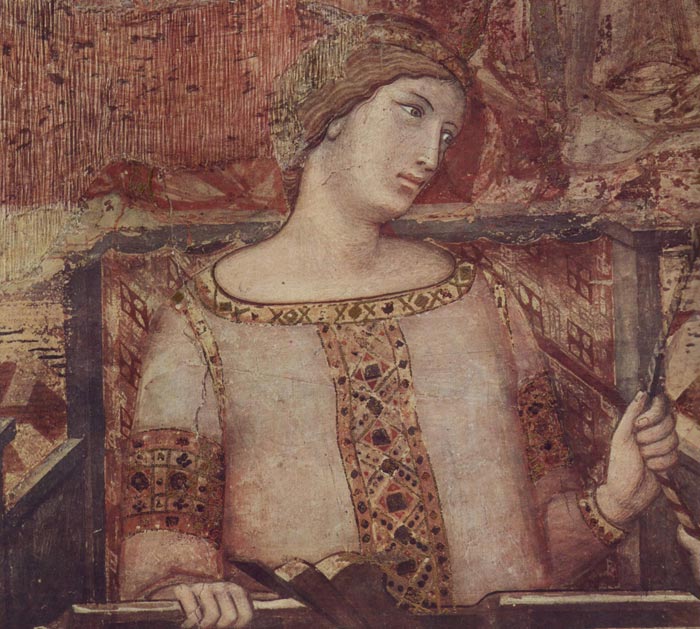 |
||||
Ambrogio Lorenzetti, Allegory of Good Government (detail), Palazzo Pubblico, Siena, 1338-40
|
||||
| Unlike Pietro Lorenzetti, Ambrogio shows no signs of the influence of Duccio in his painting. He is known to have been in Florence earlier than 1321, and his earliest known painting was found in Florentine territory: dated 1319, it comes from the church of Sant'Angelo at Vico l'Abate, and is now in the Musea di Cestello in Florence. However, the spirit of Giotto visible even in this work does not tend, as in Pietro, to create three-dimensionality by means of strong contrasts of colour and of light and shade, but rather to define the structure of the forms by a precise vigour of outline, and with strong lines surrounding clear and vivid chromatic planes. Even his experiments in perspective, which Ambrogio pursued instinctively and in which he attained some fascinating results, are to be seen in this tension between line and colour. In 1324 the artist was in Siena, where he must have done a lot of work, as we see from numerous pictures including - presumably in this period - a Madonna at Brera and the famous Madonna del Latte, formerly in the monastery of Lecceto and now in the Archbishop's Palace in Siena. The calm, gentle and interconnected development of the linear structures here bind the image of the Child to that of the Mother in an admirable and moving unity of composition. But in 1327 he is recorded as being a member of the "Arte dei Medici e Speziali" in Florence, the guild to which painters and pigment merchants also belonged. Two important altarpieces used to be in the Florentine church of San Procolo, a triptych which seems once to have borne the signature and the date of 1332, now vanished, and which was reconstructed at the Uffizi in1959, and an altar-frontal, which like Martini's altarpiece of the Blessed Agostino Novella, appears to have had in the centre an image of St. Nicholas of Bari, now either lost or unidentified, flanked by four panels depicting miracles performed by the Saint, now preserved in the Uffizi. In these panels the artist may have given one of the earliest proofs of his skill at architecture and landscape, qualities that foreshadow the frescoes of the Good and Bad Government: the great frescoes in the Palazzo Pubblico in Siena which allegorically sum up so much of the ideals of 14th-century Tuscany, and incidentally give us a most wonderful and exact picture of the daily life and customs of the time. |
||||
Allegory and Effects of Good and Bad Government in the Countryside (dettaglio) (1338-1339), Parete di sinistra della Sala dei Nove, Palazzo Pubblico, Siena |
||||
Ambrogio Lorenzetti's most revolutionary achievement - one of the most remarkable accomplishments of the Renaissance - is the fresco series that lines three walls of the room in the Palazzo Pubblico where Siena's chief magistrates, the Nine, held their meetings (Sala dei Nove). These frescoes are collectively known as Allegory and Effects of Good and Bad Government. |
||||
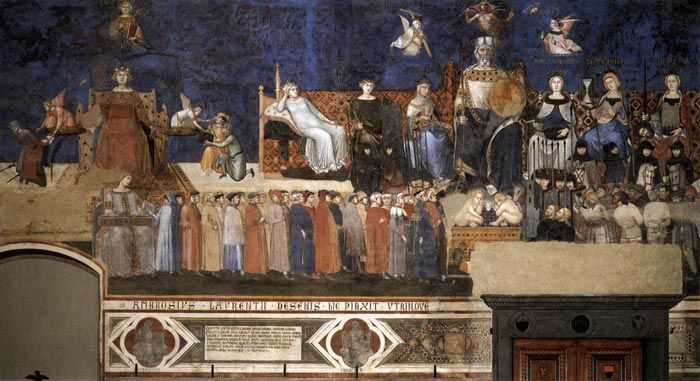 |
||||
|
|
||||
| Ambrogio Lorenzetti frescoed the side walls of the Council Room (Sala dei Nove) of the City Hall, the Palazzo Pubblico, of Siena. The subject of the frescoes are the Good and Bad Government and their effects on the life of the cities and villages. The Allegory of the Good Government is situated on the smaller wall opposite to the windows. The composition is built up from three horizontal bands. In the foreground the figures of contemporary Siena are represented. Behind them, on a stage, there are allegoric figures in two groups, representing the Good Government. The two groups are connected by the procession of the councillors. The upper band indicates the heavenly sphere with the floating bodyless ghosts of the virtues. The enthroned man on the right side of the middle band represents the city of Siena and embodies the Good Government. Around his head the four letters C S C V (Commune Saenorum Civitatis Virginis) explain his identity. At his feet the two plating children are the sons of Remus, Ascius and Senius, the founders of Siena according to the Roman legends. On both sides of Siena the virtues of Good Government are represented by six crowned, stately female figures: Peace, Fortitude and Prudence on the left, Magnanimity, Temperance and Justice on the right. On the far left of the fresco the figure of Justice is repeated as she is balancing the scales held by Wisdom. The legend has it that Siena was established by Senius, son of Remus and nephew of Romulus. Therefore the symbol of Siena is a she-wolf breastfeeding Romulus and Remus. This symbol has been repeated in different parts of town and pieces of art. Ambrogio Lorenzetti, Allegoria del Buon Governo, immages
|
||||
Ambrogio Lorenzetti, Allegoria del Buon Governo. La parete Nord ed un scorcio della parete Est (Effetti del Buon Governo in città) della Sala dei Nove del Palazzo Pubblico
|
Ambrogio Lorenzetti, Allegoria del Buon Governo), la parete Est (Effetti del Buon Governo in città e in campagna) della Sala dei Nove del Palazzo Pubblico |
Ambrogio Lorenzetti, Allegoria del Cattivo Governo ed effetti del Cattivo Governo in città e in campagna, la parete Ovest della Sala dei Nove del Palazzo Pubblico
|
||
 |
 |
 |
||
Ambrogio Lorenzetti, Allegoria del Buon Governo, 1338-1339, Sala della Pace, Palazzo Pubblico, Siena |
Ambrogio Lorenzetti, Effetti del Buon Governo in città, 1338-1339, Sala della Pace, Palazzo Pubblico, Siena |
Ambrogio Lorenzetti, Effetti del Buon Governo in campagna, 1338-1339, Sala della Pace, Palazzo Pubblico, Siena
|
||
|
||||
|
||||
La Sicurezza, con il suo confortante cartiglio
|
La Sicurezza |
La Lupa romana sulle mura cittadine |
||
|
||||
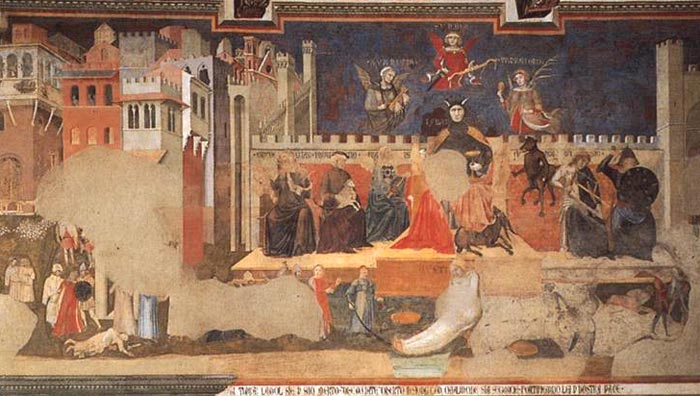 |
||||
Ambrogio Lorenzetti, Bad Government and the Effects of Bad Government on the City Life (detail), fresco in the Palazzo Pubblico, Siena The court of bad justice is governed by a devil holding a poison cup. He has a foot on a goat's horns and his eyes are crossed. Floating above his head are Avarice, Pride, and Vainglory. Sinners surround him. War, Treason, and Fury sit to his left, and Discord, Fraud, and Cruelty on his right. Justice is bound, and her scales fallen. |
||||
On the wall opposite the Effect of Good Government and to the left of the Good Government Ambrogio painted another fresco called Bad Government and the Effects of Bad Government on the City Life, which uses the same forms and compositional devices as the other frescoes in the room, but inverts them. The malevolent-looking figure representing Bad Government, pointedly labeled as Tyranny, is enthroned and stares hieratically out at the observer.. Neither male nor female, it is fanged, cross-eyed, and porcine, clearly bloated with corruption. In place of the cardinal virtues, personifications of Avarice, Pride, and Vainglory fly over its head. Tyranny is flanked by clearly labeled seated figures representing Cruelty, Treason, and Fraud at the left, and Frenzy, Divisiveness, and War at the right. A bound figure representing Justice lies at its feet. The city to its left is falling into ruin, robbers roam the streets, and, in the foreground, a group of ruffians drags a woman by her hair. Even in its now ruinous condition the image conveys a dire warning.
|
||||
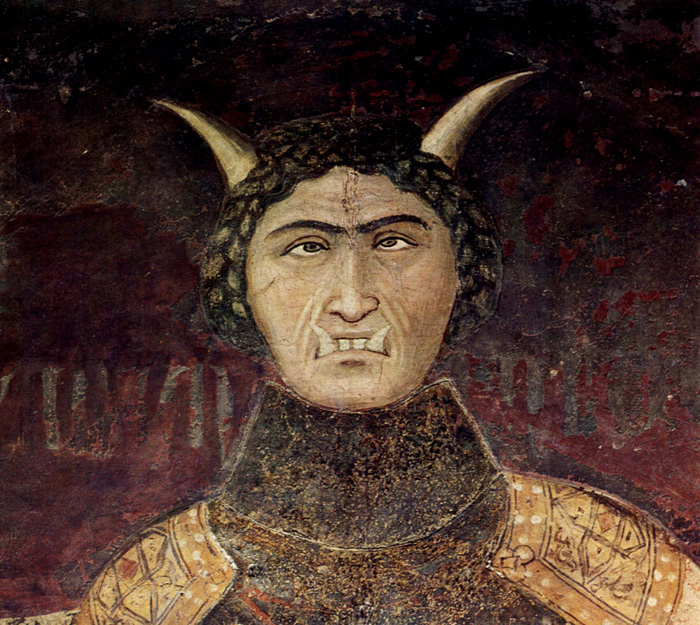 |
||||
Effects of Bad Government (detail, the Tyrant in Allegory of Bad Government) |
||||
When the viewer turns to examine the Effects of Bad Government mural, they are confronted with a devious looking figure adorned with horns and fangs, and appearing to be cross-eyed. This figure is identified as TYRAMMIDES (Tyranny). He sits enthroned, resting his feet upon a goat (symbolic of luxury), and in his hand he sinisterly holds a dagger.
|
||||
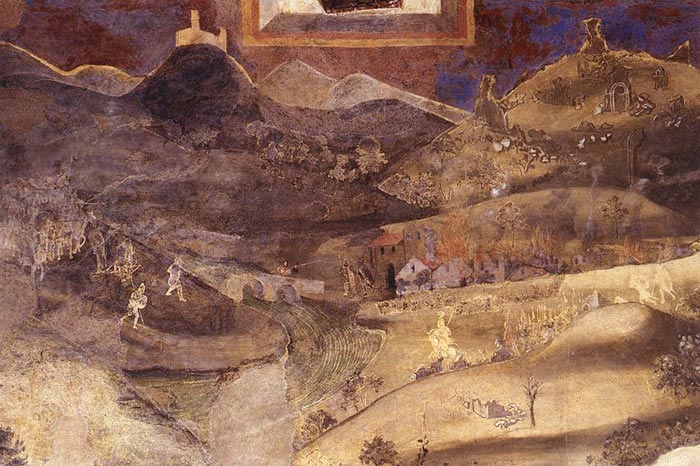 |
||||
Effects of Bad Government on the Countryside (detail), 1338-40, fresco in Palazzo Pubblico, Siena |
||||
|
||||
| In the hilly countryside the only activities are ones of death and destruction, setting fire to isolated houses and whole villages. The countryside is bare and barren, the trees bear no fruit and no one is cultivating the land. The Allegory of the Bad Goverment is situated on the wall opposite to Allegory of Good Government. At the centre of the dais sits Tyrannia, with the appearence of a demon, with horns and fangs. The figure of Tyranny has flowing woman's hair, a cloak with gold embroidery and precious stones, a gold cup in her hand and a goat, the traditional symbol of lust, at her feet. Below is the vanquised Justitia: the scales are broken and scattered around her on the ground. Around Tyranny's throne are gathered the Vices. |
||||
|
||||
This fresco is located on the north wall of the Cappella dei Signori in the Palazzo Pubblico. The Cappella dei Signori was constructed in about 1404-05 on the first floor of the Palazzo Pubblico, next to the important Sala del Mappamondo. As soon as the Cappella dei Signori was finished, the government commissioned Taddeo di Bartolo to paint its walls and vaulting, paying him for the work at regular intervals between 1406 and 1408.
|
||||
|
||||
|
||||
Podere Santa Pia |
Val d'Orcia
|
|||
Hidden away from mass-tourism, discover a piece of Italy which remains largely unchanged both nature and lifestyle-wise. The peacefulness of the countryside, the various unique villages and the friendly atmosphere will no doubt pleasantly surprise you!
|
||||
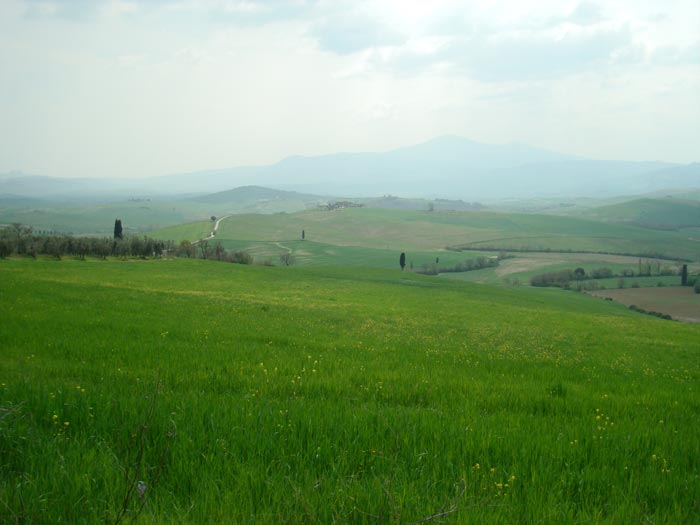 |
||||
Val d'Orcia, between Pienza and Podere Santa Pia |
||||


